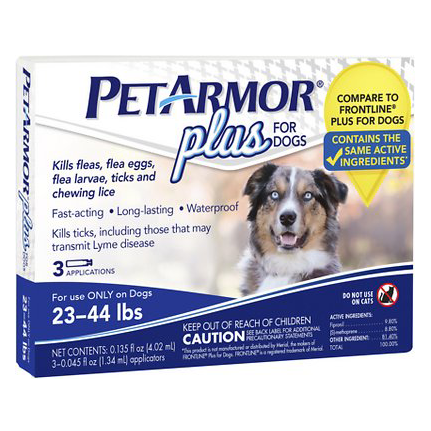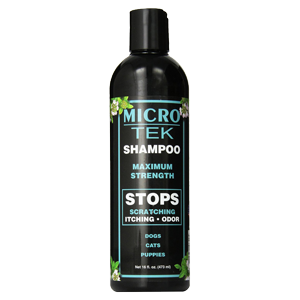
Adult fleas live on their host, rarely leaving. Infested dogs are constantly being fed upon. The first priority when battling fleas is to relieve pet discomfort. Immediate and lasting control is achieved with flea drops.
Supplies
Dogs & the Flea Life Cycle
Flea Life Cycle & Habitats
Adult fleas are permanent residents of their host. They remain on dogs to feed, mate, and lay eggs. The non-sticky eggs fall from the dog’s fur within a few hours of being laid. The eggs then develop in the environment, transitioning into larvae, pupae, and eventually new adults. Populations consist of 50-57% eggs, 34-35% larvae, 8-10% pupae, and 1-5% adults.
Flea eggs take 17-26 days to mature into adults. Unfortunately, some adults remain inside their cocoons and enter into a quiescent (dormant-like) state. This “sleep” can last up to 5 months. Thus, large numbers of adult fleas will emerge for around a month, but lower numbers will continue emerging well into the future.
Killing Existing Adult Fleas isn’t Enough
It’s crucial to treat dogs with a product designed for long-term control. Only killing the existing adults won’t end an infestation. The bulk of the population consists of immature stages living in the environment (usually carpets). For months, new adults will continue emerging to infest pets. New females will mate and begin laying eggs in two days, at a rate of 25 eggs a day. The infestation will continue to thrive.
Flea Drops for Dogs
Long-term Control
Topical drops are effective for getting rid of fleas on a dog because they’re long-lasting. Existing fleas are killed, and new fleas that jump onto the treated dog are killed. Re-application is only needed once every 30 days. Treatments are typically given for 3-4 months to ensure the entire population is eliminated, thus preventing re-infestation. However, year-round or seasonal control is also an option.
Dual-Action
Modern flea drops are dual-action. They contain two primary active ingredients: an adulticide to kill adult fleas, and an insect growth regulator (IGR) to inhibit immature stages and sterilize adult females.
Common adulticides found in flea drops are imidacloprid or fipronil. The adulticide quickly kills existing adult fleas, relieving the dog from its flea burden and new bites. The insecticide remains active for 30 days, killing any new fleas that jump onto the dog before they have a chance to reproduce.
Common IGRs in flea drops are pyriproxyfen (Nylar) or methoprene (Precor). The IGR sterilizes female fleas, so they can’t lay viable eggs even if they survived the adulticide. In addition, any eggs or larvae that get exposed to the IGR are unable to develop and reach maturity.
Insecticides are rarely 100% effective. Combining adulticides and IGRs adds redundancy to fills in the gaps, ensuring that the fleas can’t reproduce. Without a new generation, the eventual elimination of the population is assured.
Modern flea drops alone can end mild to moderate infestations. However, treating and sanitizing the environment is also recommended to add redundancy and speed up the eradication process (see steps 3-5 in integrated flea control).
Popular Flea Drops for Dogs
Tips for Success
Don’t Quarantine Treated Dogs
Once dogs are properly treated, allow them to roam free. They will return to their favored resting spots, which will also be flea hot-spots. Fleas emerging from the environment will jump onto the treated dogs and die. When a dog lays down, heat and pressure will also force quiescent cocooned adults wake up, emerge, and die. This will help eradicate fleas on the premises faster.
Some of the insecticide from the flea drops will rub off into the environment. Environmental transfer typically occurs where dogs rest and groom themselves. Again, the same areas where immature fleas are developing. The residual insecticide that rubs off into the environment will help kill or inhibit the fleas living there.
Be Patient
Flea treatments don’t kill fleas immediately. It may take several hours, and up to 36 hours in some cases. Whenever a treated dog encounters a flea hot-spot, many new fleas will be seen on the dog. However, they should be small and unfed, in the process of dying. The fleas will ultimately die if the dog was appropriately treated.
It usually takes around 8 weeks (sometimes longer) before an infestation completely ends. All of the young environmental stages need to mature, emerge, and die.
Other Tips
- Treat all pets in the home, even those without fleas.
- Apply the correct dosage of drops. Don’t split treatments between dogs.
- Apply drops to the dog’s skin, not fur.
- Apply drops when the dog is dry.
- Don’t allow a lapse in treatment.
- Don’t stop treatment early, even during winter.
- After treatment, don’t immerse dogs in water more than once weekly.
- Don’t switch products. Reserve this as a last resort.
- Oral treatments may be a better option for dogs with a skin disease.
For more details on these tips, please visit our page on Why Flea Control Fails
Optional Soothing shampoo
Bathing dogs with a soothing, anti-itch shampoo will help relieve existing flea bites. If shampooing is done prior to applying flea drops, allow dogs to thoroughly dry before administering treatments. If shampooing is done after applying flea drops, wait at least four days after treating the dog.
A variety of flea shampoos are on the market. While they may kill existing fleas on the dog, they don’t offer long-term control. Monthly flea drops are typically still needed.




You must log in to post a comment. Log in now.